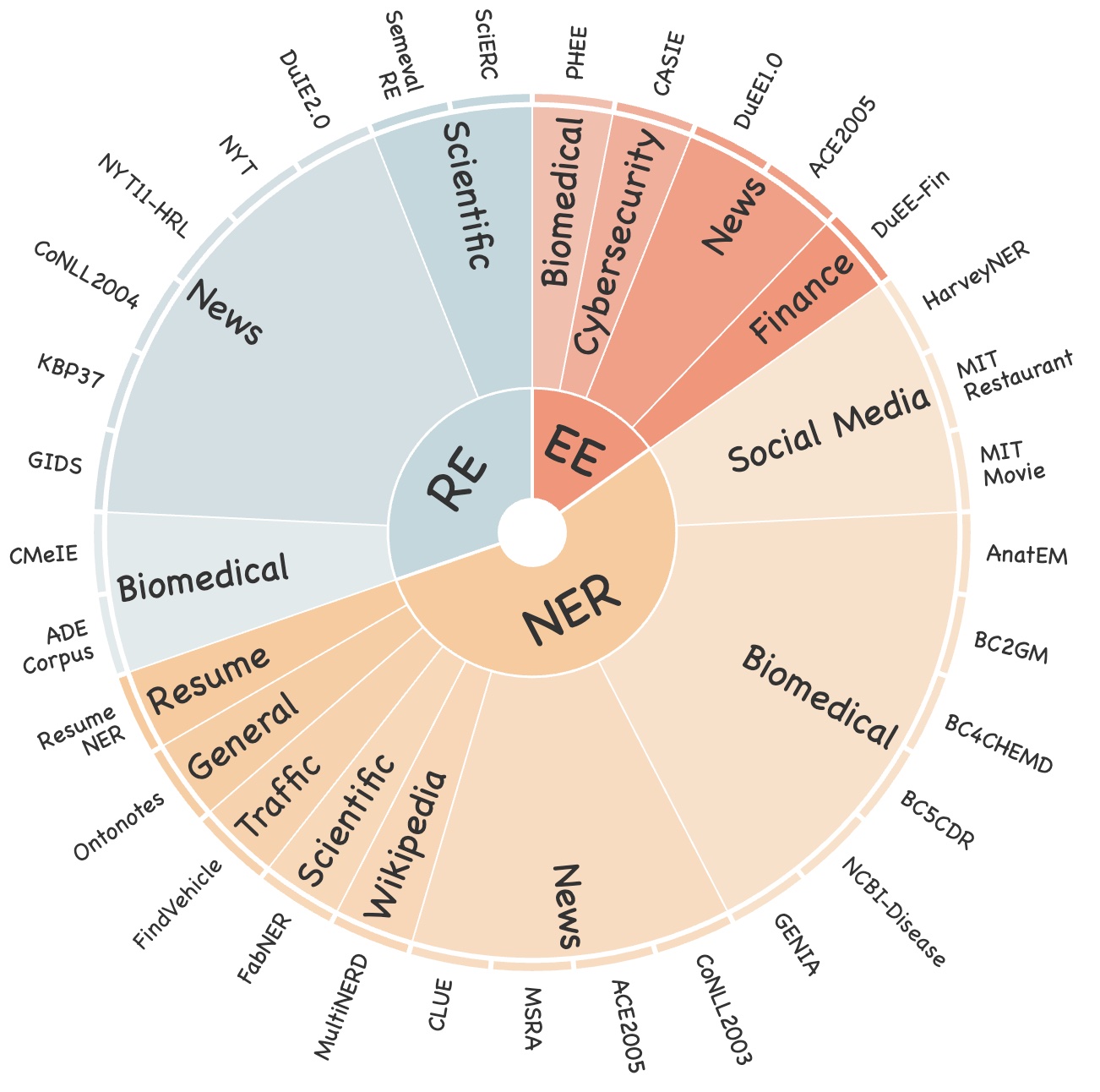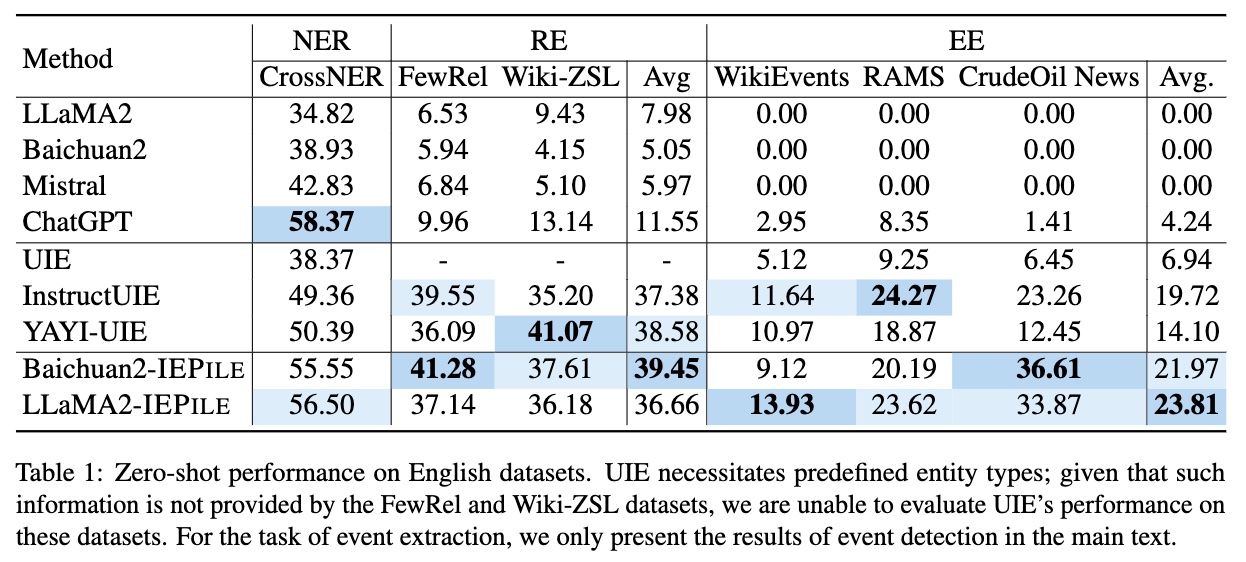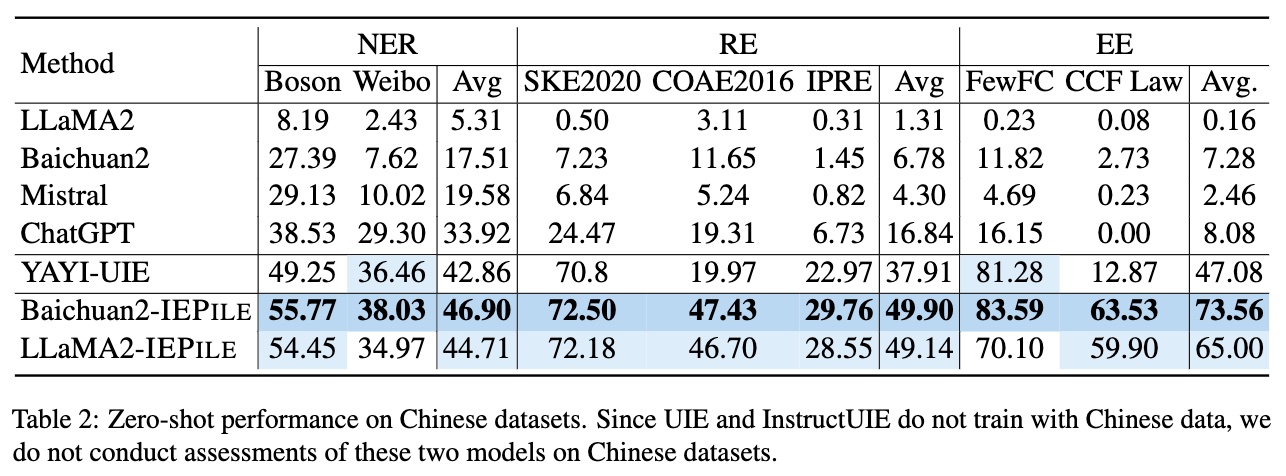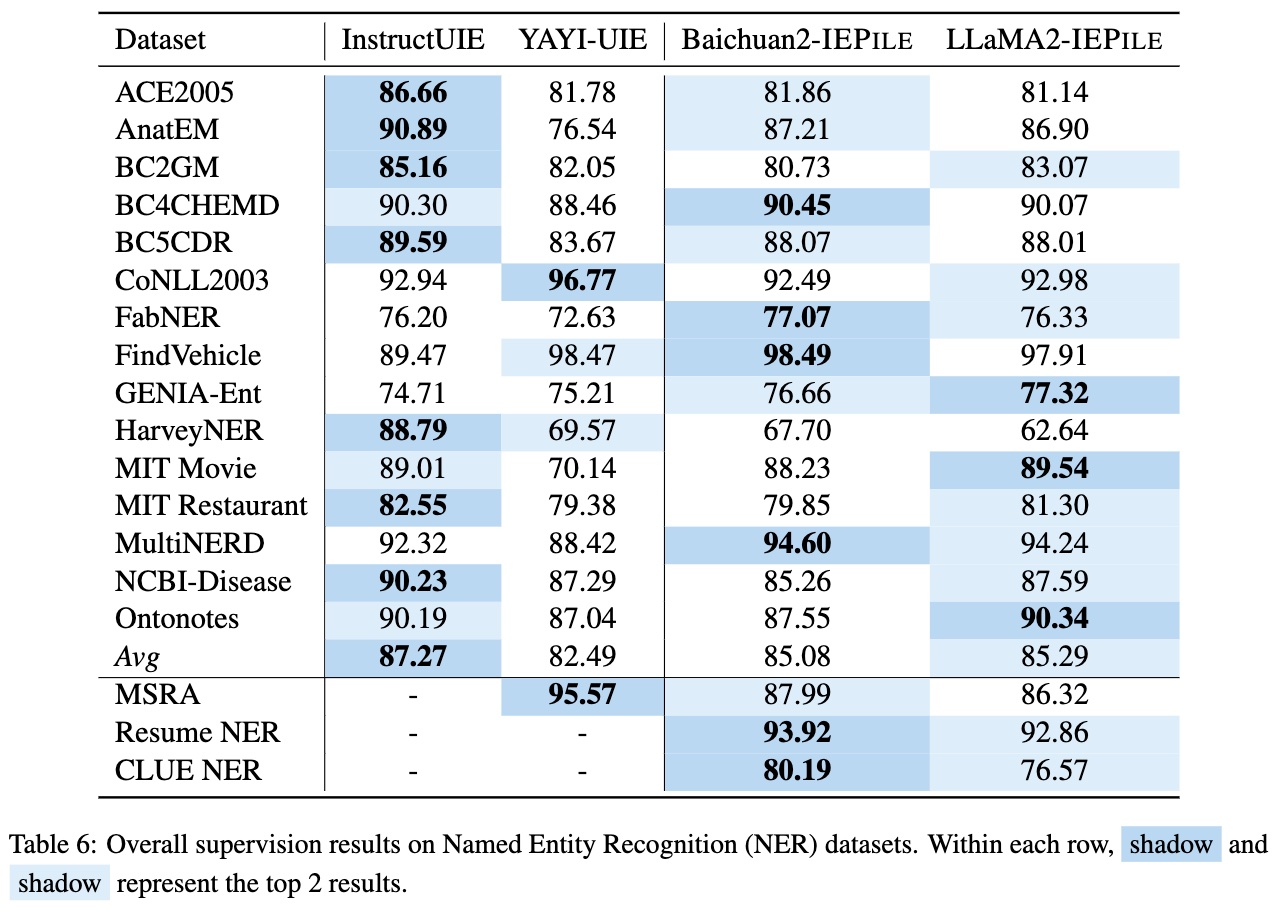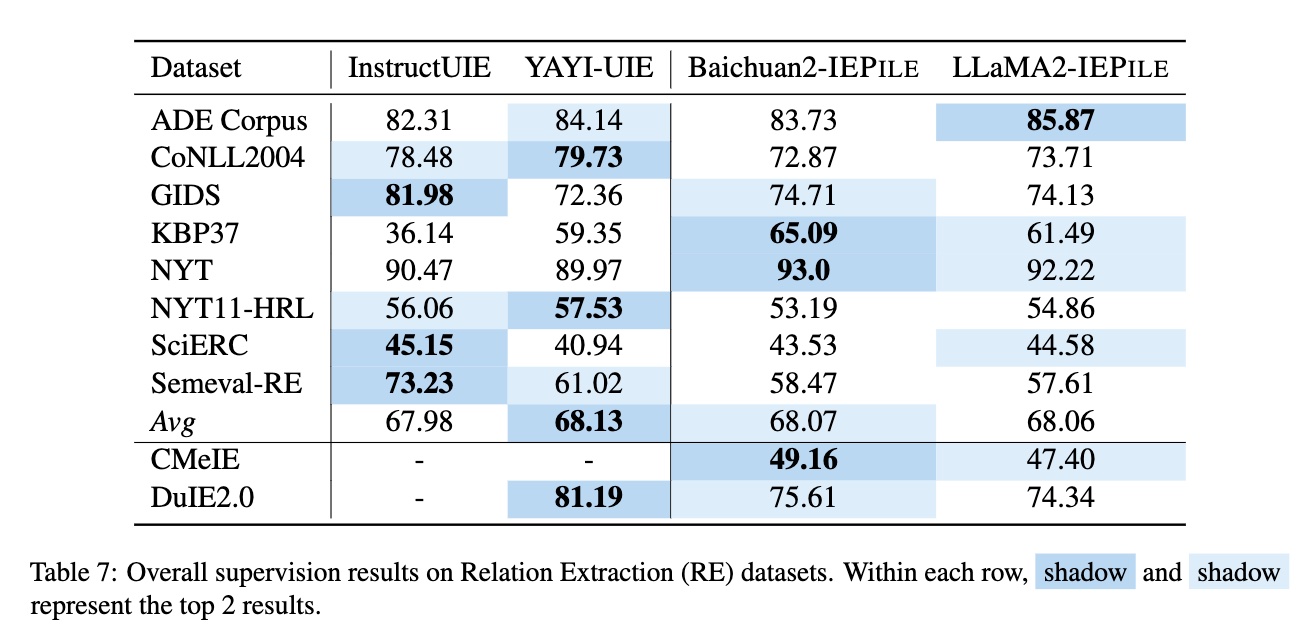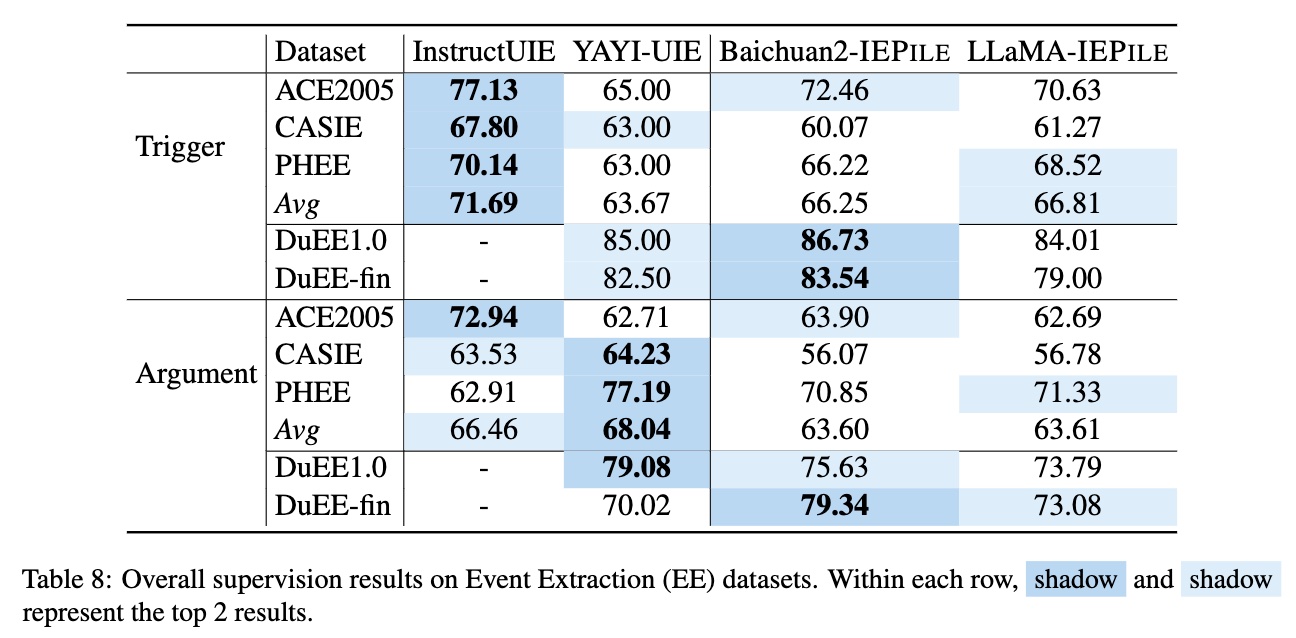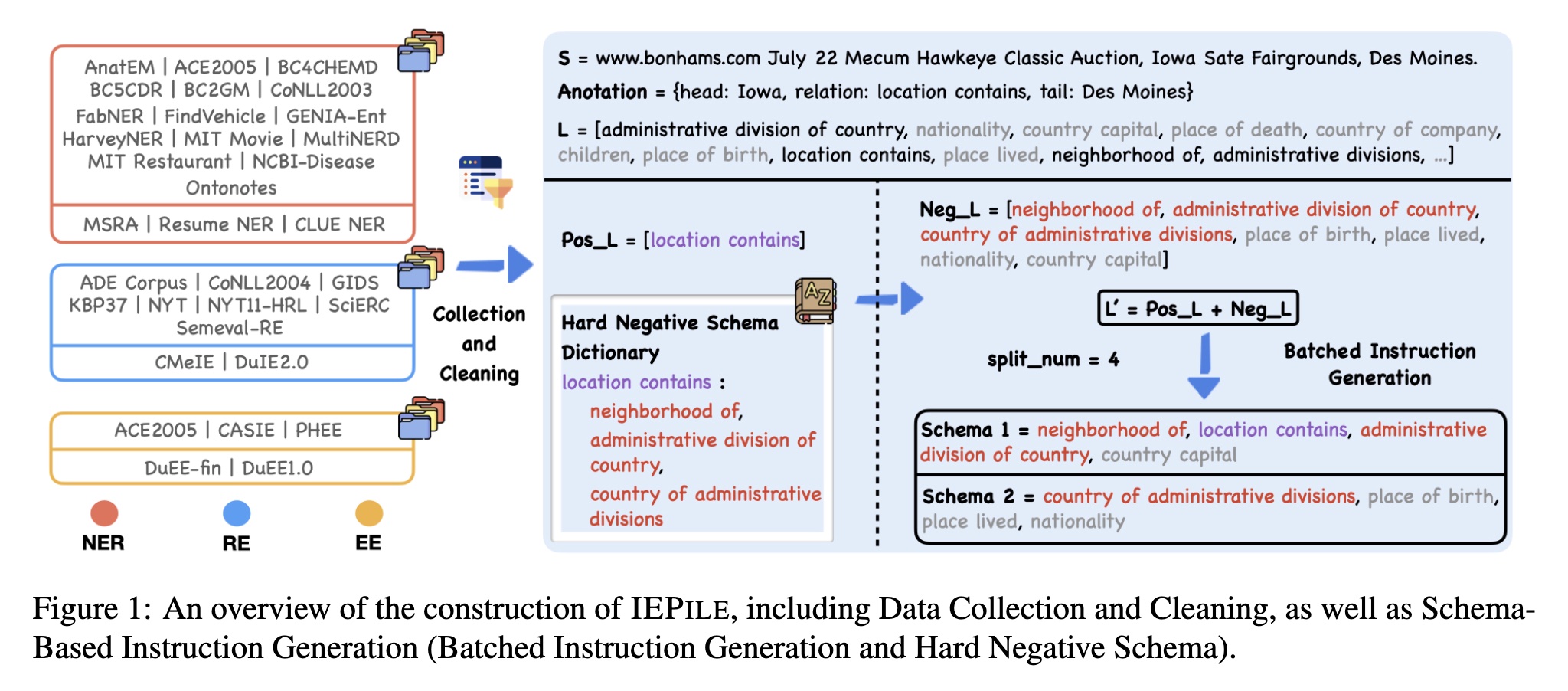license: cc-by-nc-sa-4.0
task_categories:
- text2text-generation
language:
- en
- zh
English | Chinese
IEPile: A Large-Scale Information Extraction Corpus
This is the official repository for IEPile: Unearthing Large-Scale Schema-Based Information Extraction Corpus
Datasets | Paper | Usage | Limitations | Statement & License | Citation
Please note that our IEPile may undergo updates (we will inform you upon their release). It is recommended to utilize the most current version.
IEPile
├── train.json # Training Set
├── dev.json # Validation Set
├── IE-en # English Unified Format Data
│ ├── NER
│ │ ├── CoNLL2003
│ │ │ ├── train.json
│ │ │ ├── dev.json
│ │ │ ├── schema.json # schema information file
│ │ │ └── test.json
│ │ ├── ...
│ ├── RE
│ ├── EE
│ ├── EET
│ ├── EEA
├── IE-zh # Chinese Unified Format Data
│ ├── NER
│ ├── RE
│ ├── EE
│ ├── EET
│ ├── EEA
1.Introduction
Please be aware that the data contained in the dataset provided above has already excluded any part related to the ACE2005 dataset. Should you require access to the unfiltered, complete dataset and have successfully obtained the necessary permissions, please do not hesitate to contact us via email at guihonghao@zju.edu.cn or zhangningyu@zju.edu.cn. We will provide the complete dataset resources for your use.
Model download links for LLaMA2-IEPile | Baichuan2-IEPile | knowlm-ie-v2(based on Baichuan2): zjunlp/llama2-13b-iepile-lora | zjunlp/baichuan2-13b-iepile-lora | zjunlp/KnowLM-IE-v2
We have meticulously collected and cleaned existing Information Extraction (IE) datasets, integrating a total of 26 English IE datasets and 7 Chinese IE datasets. As shown in Figure 1, these datasets cover multiple domains including general, medical, financial, and others.
In this study, we adopted the proposed "schema-based batched instruction generation method" to successfully create a large-scale, high-quality IE fine-tuning dataset named IEPile, containing approximately 0.32B tokens.
Based on IEPile, we fine-tuned the Baichuan2-13B-Chat and LLaMA2-13B-Chat models using the Lora technique. Experiments have demonstrated that the fine-tuned Baichuan2-IEPile and LLaMA2-IEPile models perform remarkably on fully supervised training sets and have achieved significant improvements in zero-shot information extraction tasks.
2.Data
2.1Construction of IEPile
We concentrate on instruction-based IE, thus the construction of schema within the instructions is crucial. This is because they reflect the specific extraction requirements and are dynamically variable. Previous approaches with existing IE datasets often employ a rather extensive schema processing strategy when constructing instructions, utilizing all schemas within a label set for instruction building, raising two potential issues:
- Inconsistency in the number of schema queries within instruction between training and evaluation. For example, the model's performance will decrease if it is trained on about 20 schema queries but tested with either 10 or 30, even if the training and evaluation schemas are similar in content.
- Inadequate differentiation among schemas in the instructions. For example, semantically similar schemas like "layoffs", "depart" and "dismissals", may present co-occurrence ambiguities that could confuse the LLMs. Such schemas should co-occur more frequently within the instruction.
Therefore, we introduce the following solutions: 1)Hard Negative Schema; and 2) Batched Instruction Generation.
Hard Negative Schema
Assuming that dataset $\mathcal{D}$ possesses a full label set $L$. For a given text $S$, the schemas present in its annotation constitute the positive schema set $Pos_L$, while others form the negative schema set $Neg_L$. In our analysis, we discover that the primary cause of model misjudgment stems from the semantic ambiguity of the schema. In traditional approaches, the $Neg_L$ is simply defined as $L - Pos_L$. However, they overlook a critical aspect: it is important to pay special attention to negative schemas that are semantically close to positive schemas. Inspired by the theory of contrastive learning, we construct a hard negative schema dictionary $\mathcal{K}$, where each key represents a unique schema and the associated value is a collection of schemas that are semantically similar to the key schema. Based on this, we define the hard negative schema set as $Hard_L = \mathcal{K}[Pos_L]$, and the other negative schema set as $Other_L = L - Pos_L - Hard_L$. The final $Neg_L$ is constituted by $Hard_L$ and a small subset of $Other_L$. Through this strategy, we not only present semantically similar schemas more frequently within the instruction but also reduce the number of training instances without sacrificing model performance.
Batched Instruction Generation
Subsequently, we obtain the final schema set $L' = Pos_L + Neg_L$. We employ a batched instruction generation method, limiting the number of schemas inquired in each instruction to the number of $split_num$, which ranges between 4 to 6. Therefore, $L'$ will be divided into $|L'|/split_num$ batches for querying, with each batch querying $split_num$ schemas. Consequently, even if the number of schemas inquired during the evaluation phase differs from that of training, the batched mechanism allows us to distribute the inquiries across $split_num$ schemas, thereby mitigating the decline in generalization performance.
2.2Data Format of IEPile
Each instance in IEPile contains four fields: task, source, instruction, and output. Below are the explanations for each field:
| Field | Description |
|---|---|
| task | The task to which the instance belongs, one of the five types (NER, RE, EE, EET, EEA). |
| source | The dataset to which the instance belongs. |
| instruction | The instruction for inputting into the model, processed into a JSON string via json.dumps, including three fields: "instruction", "schema", and "input". |
| output | The output in the format of a dictionary's JSON string, where the key is the schema, and the value is the extracted content. |
In IEPile, the instruction format of IEPile adopts a JSON-like string structure, which is essentially a dictionary-type string composed of the following three main components:
(1) 'instruction': Task description, which outlines the task to be performed by the instruction (one of NER, RE, EE, EET, EEA).
(2) 'schema': A list of schemas to be extracted (entity types, relation types, event types).
(3) 'input': The text from which information is to be extracted.
The file instruction.py provides instructions for various tasks.
Below is a data example:
{
"task": "NER",
"source": "CoNLL2003",
"instruction": "{\"instruction\": \"You are an expert in named entity recognition. Please extract entities that match the schema definition from the input. Return an empty list if the entity type does not exist. Please respond in the format of a JSON string.\", \"schema\": [\"person\", \"organization\", \"else\", \"location\"], \"input\": \"284 Robert Allenby ( Australia ) 69 71 71 73 , Miguel Angel Martin ( Spain ) 75 70 71 68 ( Allenby won at first play-off hole )\"}",
"output": "{\"person\": [\"Robert Allenby\", \"Allenby\", \"Miguel Angel Martin\"], \"organization\": [], \"else\": [], \"location\": [\"Australia\", \"Spain\"]}"
}
The data instance belongs to the NER task, is part of the CoNLL2003 dataset, the schema list to be extracted includes ["person", "organization", "else", "location"], and the text to be extracted from is "284 Robert Allenby ( Australia ) 69 71 71 73 , Miguel Angel Martin ( Spain ) 75 70 71 68 ( Allenby won at first play-off hole )". The output is {"person": ["Robert Allenby", "Allenby", "Miguel Angel Martin"], "organization": [], "else": [], "location": ["Australia", "Spain"]}.
Note that the order of schemas in the output is consistent with the order in the instruction.
More Tasks Instance
{
"task": "EE",
"source": "PHEE",
"instruction": "{\"instruction\": \"You are an expert in event extraction. Please extract events from the input that conform to the schema definition. Return an empty list for events that do not exist, and return NAN for arguments that do not exist. If an argument has multiple values, please return a list. Respond in the format of a JSON string.\", \"schema\": [{\"event_type\": \"potential therapeutic event\", \"trigger\": true, \"arguments\": [\"Treatment.Time_elapsed\", \"Treatment.Route\", \"Treatment.Freq\", \"Treatment\", \"Subject.Race\", \"Treatment.Disorder\", \"Effect\", \"Subject.Age\", \"Combination.Drug\", \"Treatment.Duration\", \"Subject.Population\", \"Subject.Disorder\", \"Treatment.Dosage\", \"Treatment.Drug\"]}, {\"event_type\": \"adverse event\", \"trigger\": true, \"arguments\": [\"Subject.Population\", \"Subject.Age\", \"Effect\", \"Treatment.Drug\", \"Treatment.Dosage\", \"Treatment.Freq\", \"Subject.Gender\", \"Treatment.Disorder\", \"Subject\", \"Treatment\", \"Treatment.Time_elapsed\", \"Treatment.Duration\", \"Subject.Disorder\", \"Subject.Race\", \"Combination.Drug\"]}], \"input\": \"Our findings reveal that even in patients without a history of seizures, pregabalin can cause a cortical negative myoclonus.\"}",
"output": "{\"potential therapeutic event\": [], \"adverse event\": [{\"trigger\": \"cause \", \"arguments\": {\"Subject.Population\": \"NAN\", \"Subject.Age\": \"NAN\", \"Effect\": \"cortical negative myoclonus\", \"Treatment.Drug\": \"pregabalin\", \"Treatment.Dosage\": \"NAN\", \"Treatment.Freq\": \"NAN\", \"Subject.Gender\": \"NAN\", \"Treatment.Disorder\": \"NAN\", \"Subject\": \"patients without a history of seizures\", \"Treatment\": \"pregabalin\", \"Treatment.Time_elapsed\": \"NAN\", \"Treatment.Duration\": \"NAN\", \"Subject.Disorder\": \"NAN\", \"Subject.Race\": \"NAN\", \"Combination.Drug\": \"NAN\"}}]}"
}
{
"task": "RE",
"source": "NYT11",
"instruction": "{\"instruction\": \"You are an expert in relationship extraction. Please extract relationship triples that match the schema definition from the input. Return an empty list for relationships that do not exist. Please respond in the format of a JSON string.\", \"schema\": [\"neighborhood of\", \"nationality\", \"children\", \"place of death\"], \"input\": \" In the way New Jersey students know that Thomas Edison 's laboratory is in West Orange , the people of Colma know that Wyatt Earp 's ashes are buried at Hills of Eternity , a Jewish cemetery he was n't ; his wife was , and that Joe DiMaggio is at Holy Cross Cemetery , where visitors often lean bats against his gravestone . \"}",
"output": "{\"neighborhood of\": [], \"nationality\": [], \"children\": [], \"place of death\": [{\"subject\": \"Thomas Edison\", \"object\": \"West Orange\"}]}"
}
3.Using IEPile to Train Models
Please visit our official GitHub repository for a comprehensive guide on training and inference with IEPile.
4.Statement and License
We believe that annotated data contains the wisdom of humanity, and its existence is to promote the benefit of all humankind and help enhance our quality of life. We strongly urge all users not to use our corpus for any actions that may harm national or public security or violate legal regulations. We have done our best to ensure the quality and legality of the data provided. However, we also recognize that despite our efforts, there may still be some unforeseen issues, such as concerns about data protection and risks and problems caused by data misuse. We will not be responsible for these potential problems. For original data that is subject to usage permissions stricter than the CC BY-NC-SA 4.0 agreement, IEPile will adhere to those stricter terms. In all other cases, our operations will be based on the CC BY-NC-SA 4.0 license agreement.
5.Limitations
From the data perspective, our study primarily focuses on schema-based IE, which limits our ability to generalize to human instructions that do not follow our specific format requirements. Additionally, we do not explore the field of Open Information Extraction (Open IE); however, if we remove schema constraints, our dataset would be suitable for Open IE scenarios. Besides, IEPile is confined to data in English and Chinese, and in the future, we hope to include data in more languages.
From the model perspective, due to computational resource limitations, our research only assessed two models: Baichuan and LLaMA, along with some baseline models. Our dataset can be applied to any other large language models (LLMs), such as Qwen, ChatGLM, Gemma.
6.Cite
If you use the IEPile or the code, please cite the paper:
@article{DBLP:journals/corr/abs-2402-14710,
author = {Honghao Gui and
Lin Yuan and
Hongbin Ye and
Ningyu Zhang and
Mengshu Sun and
Lei Liang and
Huajun Chen},
title = {IEPile: Unearthing Large-Scale Schema-Based Information Extraction
Corpus},
journal = {CoRR},
volume = {abs/2402.14710},
year = {2024},
url = {https://doi.org/10.48550/arXiv.2402.14710},
doi = {10.48550/ARXIV.2402.14710},
eprinttype = {arXiv},
eprint = {2402.14710},
timestamp = {Tue, 09 Apr 2024 07:32:43 +0200},
biburl = {https://dblp.org/rec/journals/corr/abs-2402-14710.bib},
bibsource = {dblp computer science bibliography, https://dblp.org}
}
7.Acknowledgements
We are very grateful for the inspiration provided by the MathPile and KnowledgePile projects. Special thanks are due to the builders and maintainers of the following datasets: AnatEM、BC2GM、BC4CHEMD、NCBI-Disease、BC5CDR、HarveyNER、CoNLL2003、GENIA、ACE2005、MIT Restaurant、MIT Movie、FabNER、MultiNERD、Ontonotes、FindVehicle、CrossNER、MSRA NER、Resume NER、CLUE NER、Weibo NER、Boson、ADE Corpus、GIDS、CoNLL2004、SciERC、Semeval-RE、NYT11-HRL、KBP37、NYT、Wiki-ZSL、FewRel、CMeIE、DuIE、COAE2016、IPRE、SKE2020、CASIE、PHEE、CrudeOilNews、RAMS、WikiEvents、DuEE、DuEE-Fin、FewFC、CCF law, and more. These datasets have significantly contributed to the advancement of this research. We are also grateful for the valuable contributions in the field of information extraction made by InstructUIE and YAYI-UIE, both in terms of data and model innovation. Our research results have benefitted from their creativity and hard work as well. Additionally, our heartfelt thanks go to hiyouga/LLaMA-Factory; our fine-tuning code implementation owes much to their work. The assistance provided by these academic resources has been instrumental in the completion of our research, and for this, we are deeply appreciative.
